To your potential clients and employers, your career doesn't really exist if you don't have a professional portfolio. Sure, you could list your positions and accomplishments in a resume. But it doesn't remotely have the same effect as a portfolio, which actually proves that you've done what you say. It also proves that you're worth the money.
In this article, I'll lay out steps to create a career portfolio and talk about some best practices to really help it stand out from competitors.
I'll also list a few examples of industry-best portfolios, in PDF and non-PDF formats, so you know what you're striving for when trying to showcase samples of your work.
Shall we begin?
• If you're wondering how to create a professional career portfolio with minimal time and effort, this is a good place to start. If you want a portfolio with PDF files on display, this is the perfect place to start.
• Try using Authory to create a portfolio within minutes. The tool builds 90% of your portfolio for you, have a look at Authory. Check out the video on "How Authory works" — you enter the URL of the sites where your work is published, and Authory will import all your bylined work to its own database. You can now look through all your pieces in a single location.
• Next, why not incorporate a few best practices to help your portfolio stand out from the crowd? Include all or most of your content, get an AI-free content certification, and send personalized portfolios to individual clients. All of this is effortless to accomplish when using Authory.
• Finally, don't forget to look at 5 portfolio examples — with PDF files and without. These are the industry standards your portfolio should meet and ideally exceed.
How to create a professional portfolio with minimal time and effort
- Sign up for Authory (for free) via this link.
- Once you do, go to the dashboard and click "Add Content."
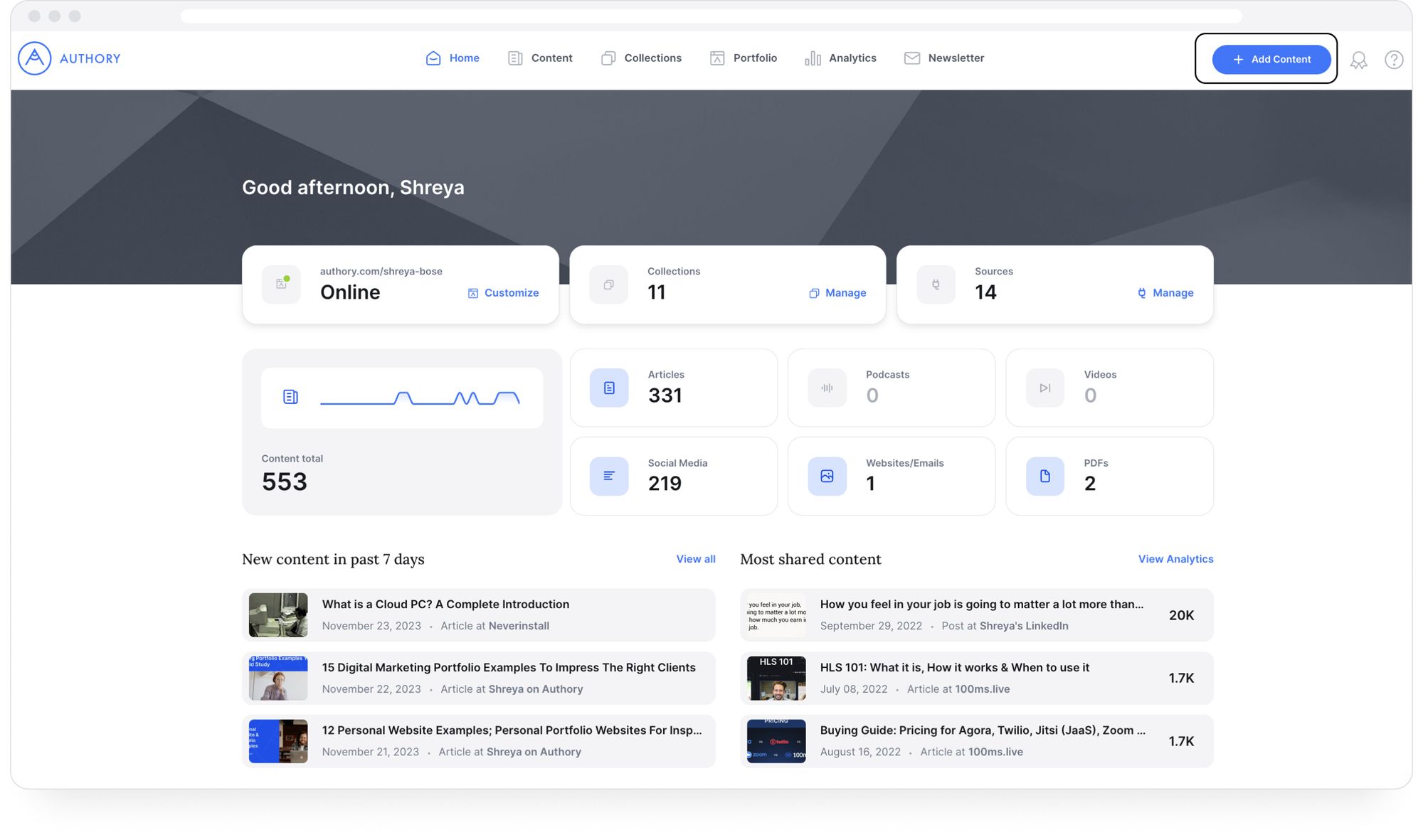
To create a PDF portfolio
- A set of options for document formats to show up. Choose "PDFs."
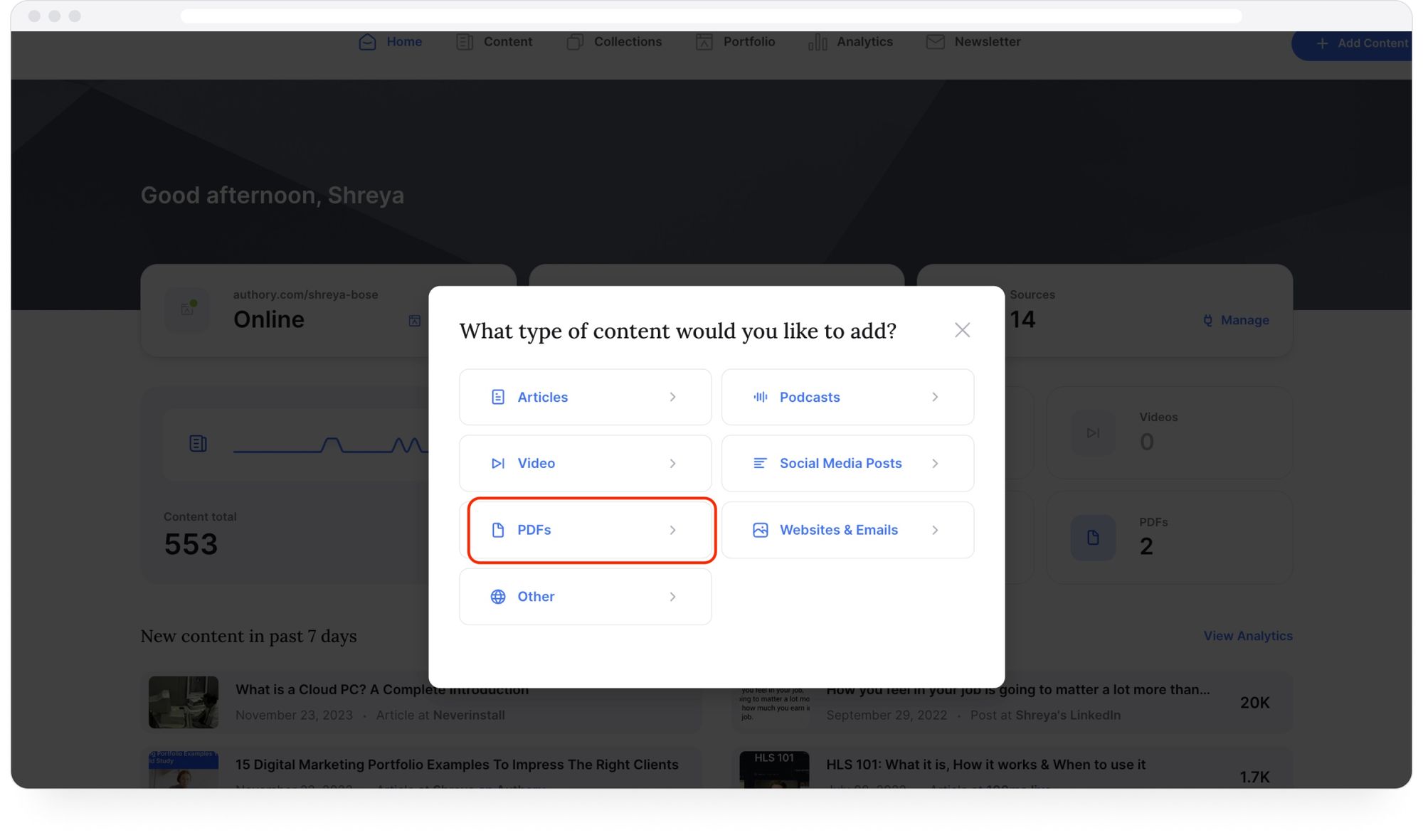
- You can choose to upload a PDF file or import it from a URL. Whichever option you choose, the next steps will remain the same. In this tutorial, I'll choose the "Import from URL" option.
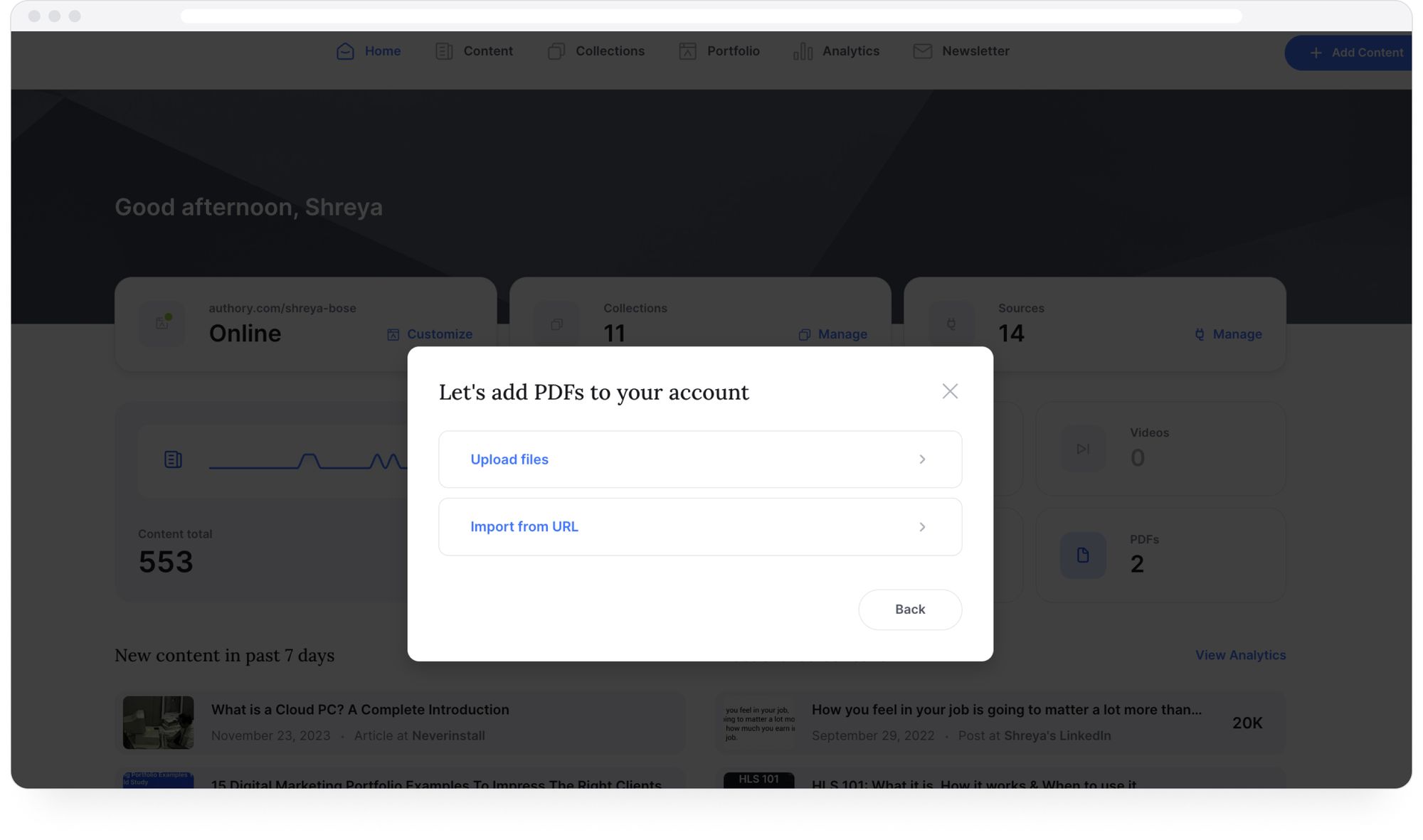
- In the next dialog box, simply paste the URL of your PDF document. Click "Add."
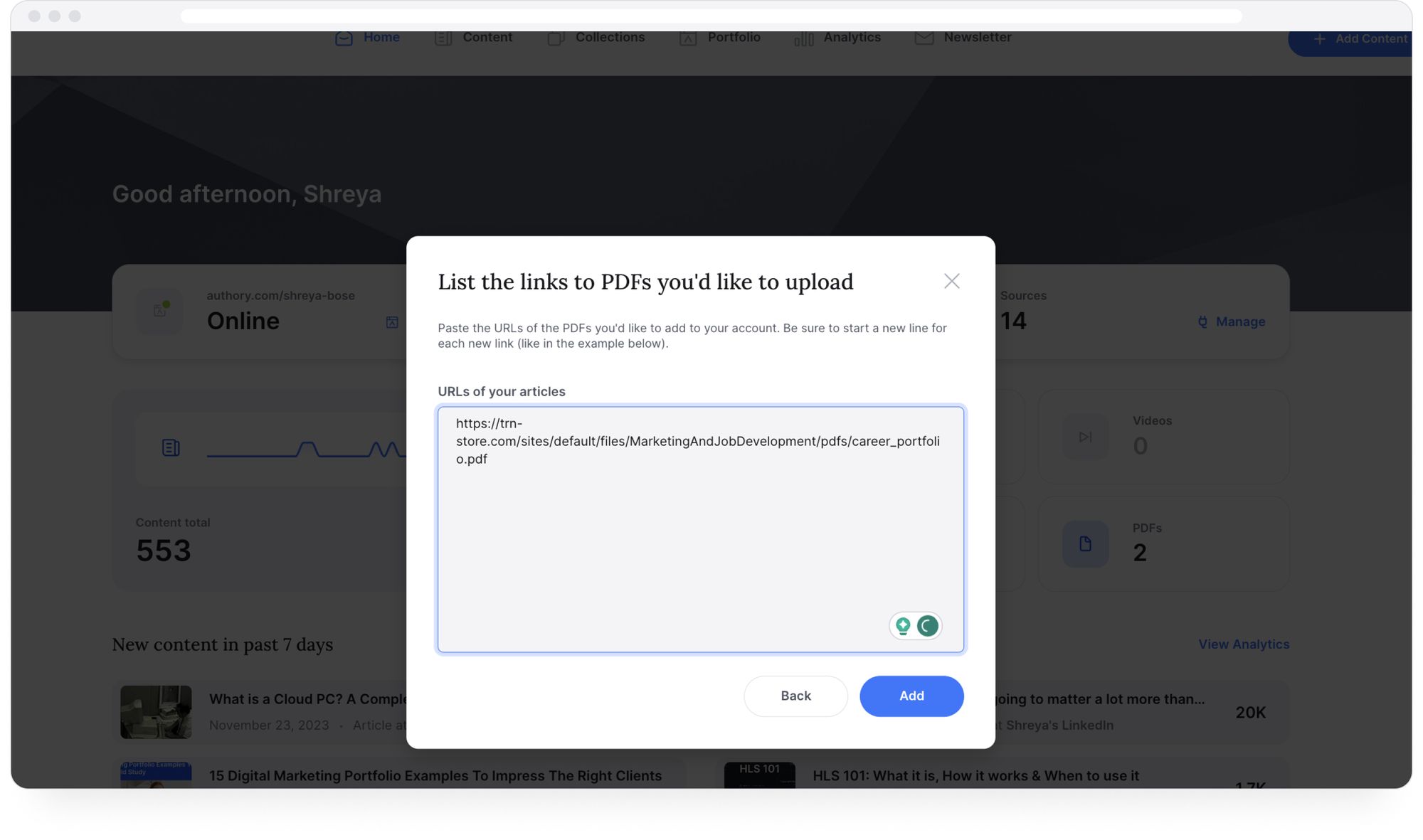
- Don’t forget to add a title and description for your file(s). You can also choose a source (the category or folder for your PDF file) to classify your content.
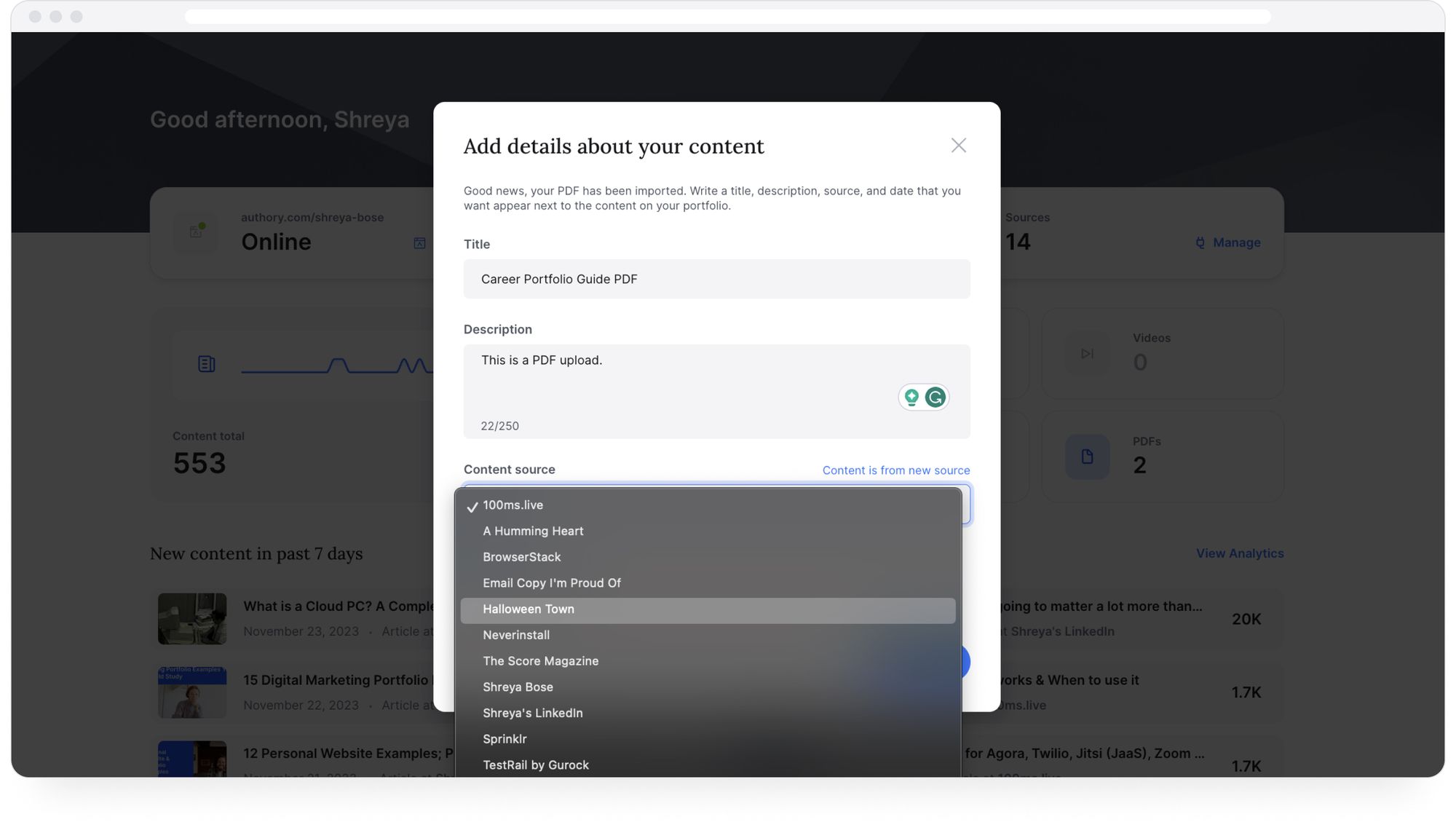
- Your document will be stored in Authory's database. To view it, click "Content" at the top.
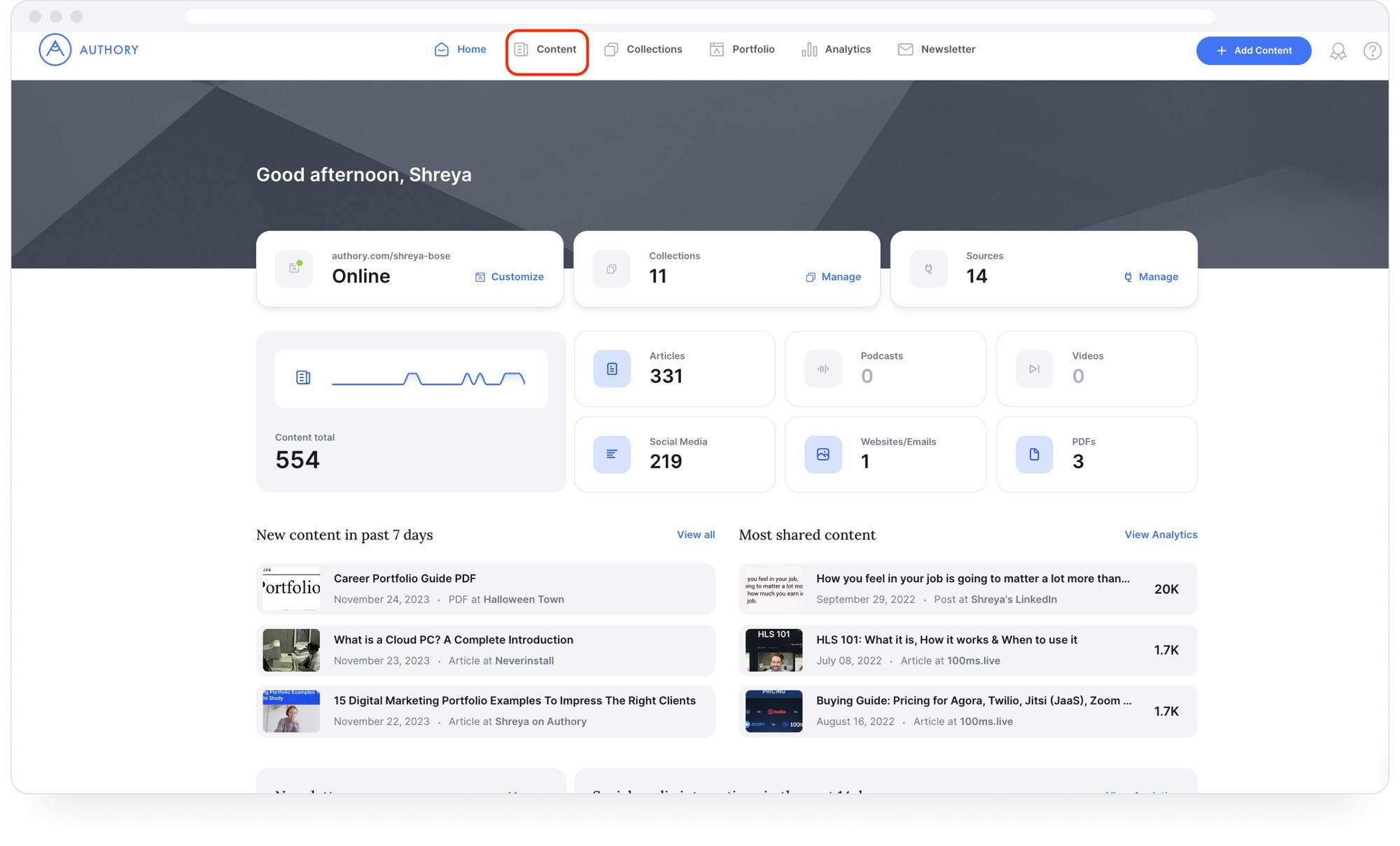
- Next, click "PDFs" under "Sources" to the left of the screen. Only the PDFs imported or uploaded to Authory will show up.
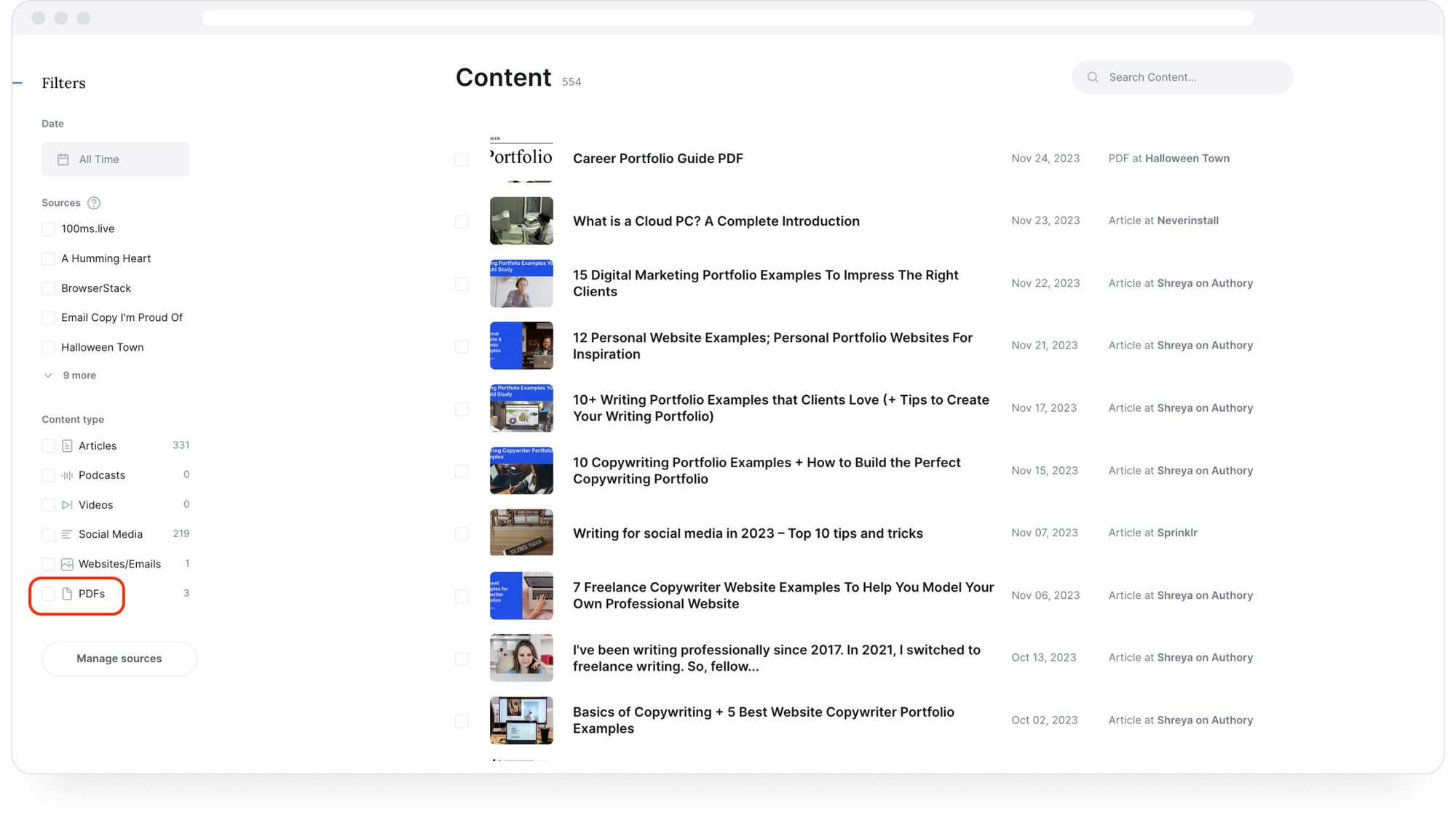
- Once you click PDFs, you’ll see all the PDF files in your database.
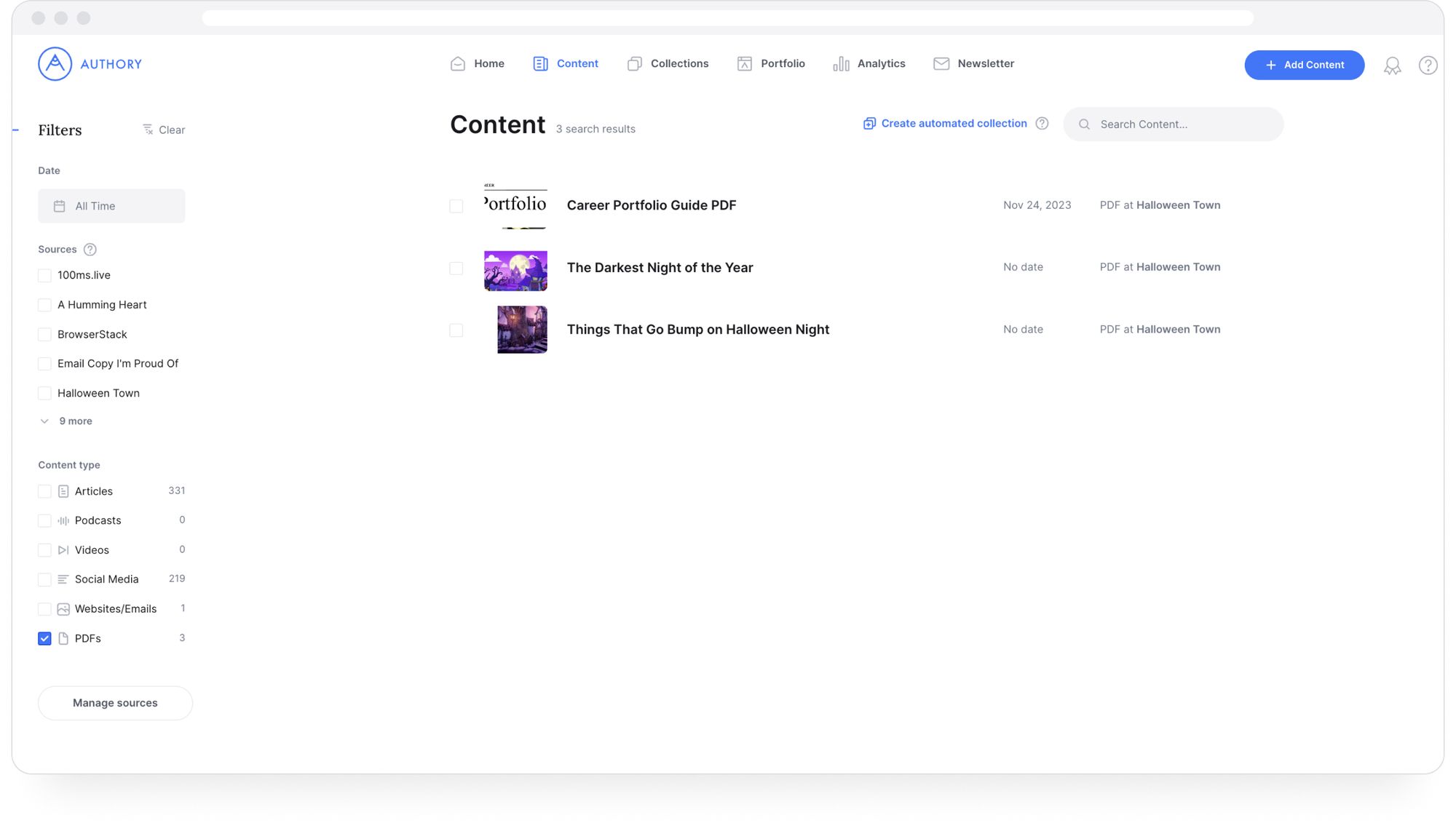
To create non-PDF career portfolios
- After clicking "Add Content," choose the format you'd like to import/upload. I chose "Articles."
- Again, a set of options shows up. You can import an article from a website, directly paste a URL, or write directly on Authory.
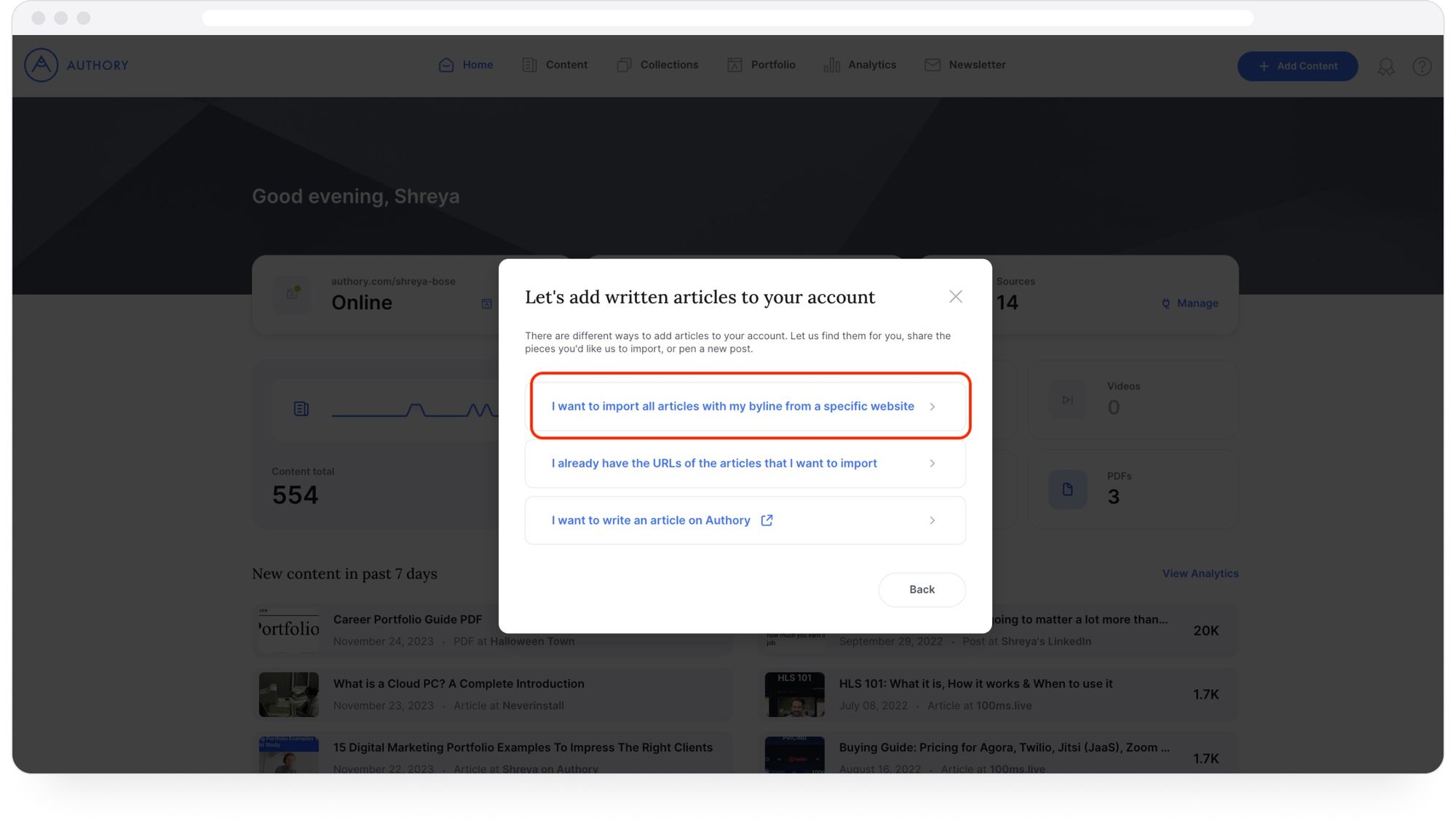
Simply paste the URL into the dialog box and click "Continue."
Authory takes about 48 hours (usually less) to import all your content from the specified URL. After that, you can simply click "Articles" in the Content dashboard to see every imported article.
Next, continue to follow the steps below to continue creating your portfolio. These steps are valid for PDF and non-PDF files.
Create a PDF or non-PDF portfolio collection
- Go back to the "Content" tab. Select the "PDFs" checkbox at the bottom left.
- Once the PDFs are selected, use the "Create automated collection" button on the top right to create a collection of your PDF uploads. There is no "add folder" option, but you can upload multiple PDF files at one go.
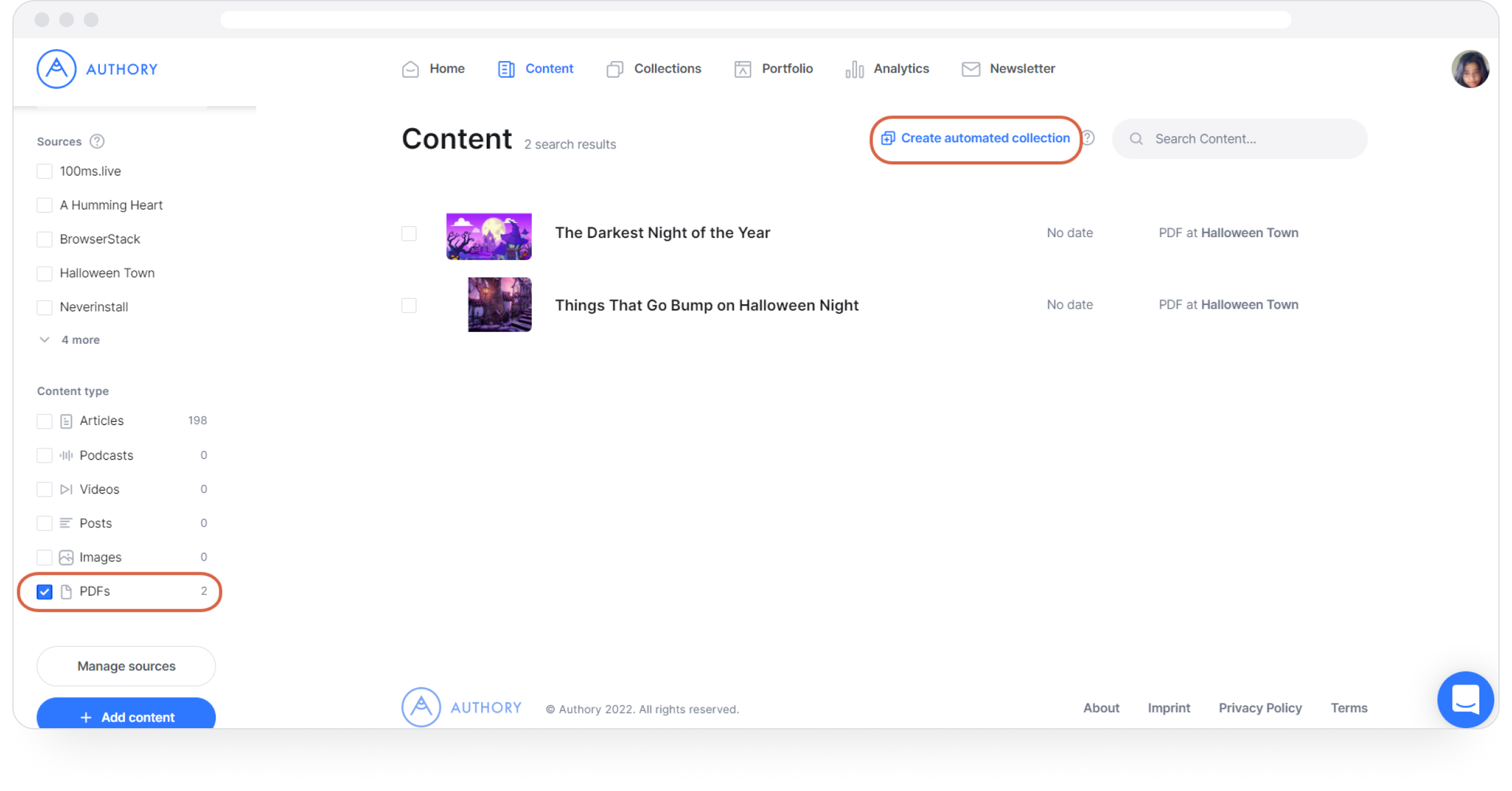
- Name your collection. Add a description if you want.
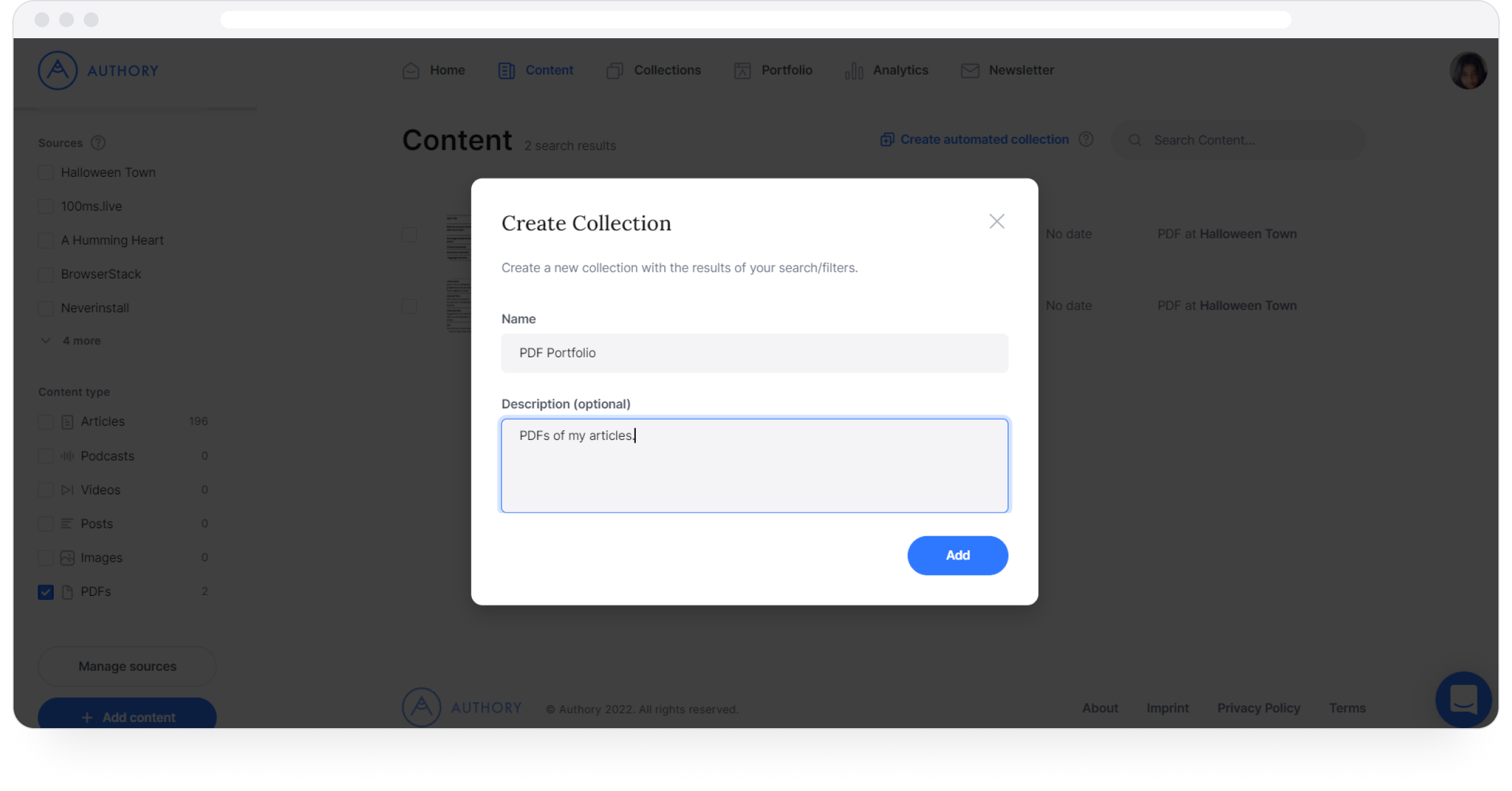
- Upload all your PDFs to this collection. Once you finish, go to the "Collections" tab to see how it looks.
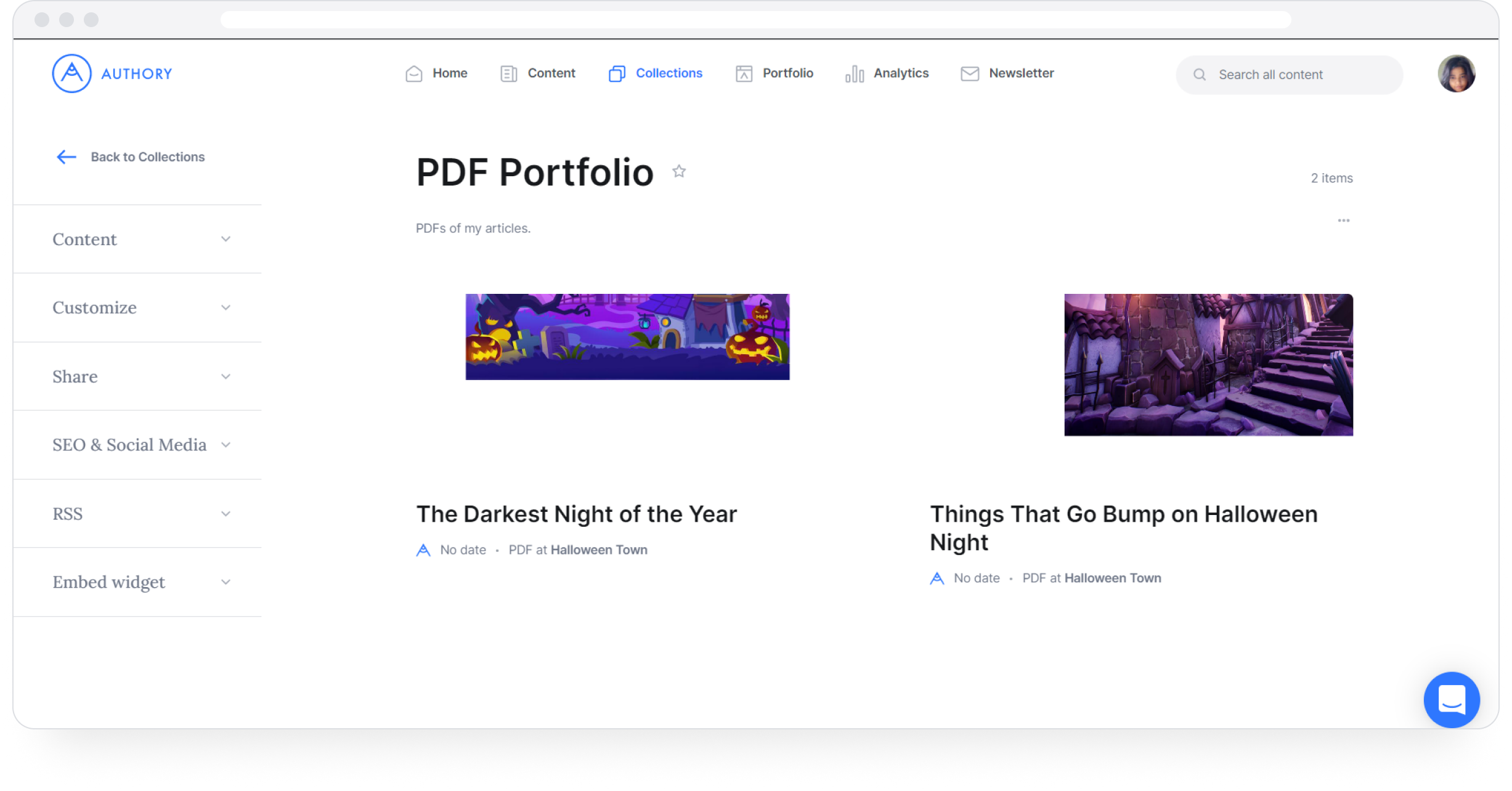
Connect the collection to your portfolio & display it
- Click on the "Portfolio" tab and go to the "Content" tab on the left menu. From there, add the previously created "PDF Portfolio" collection to the portfolio.
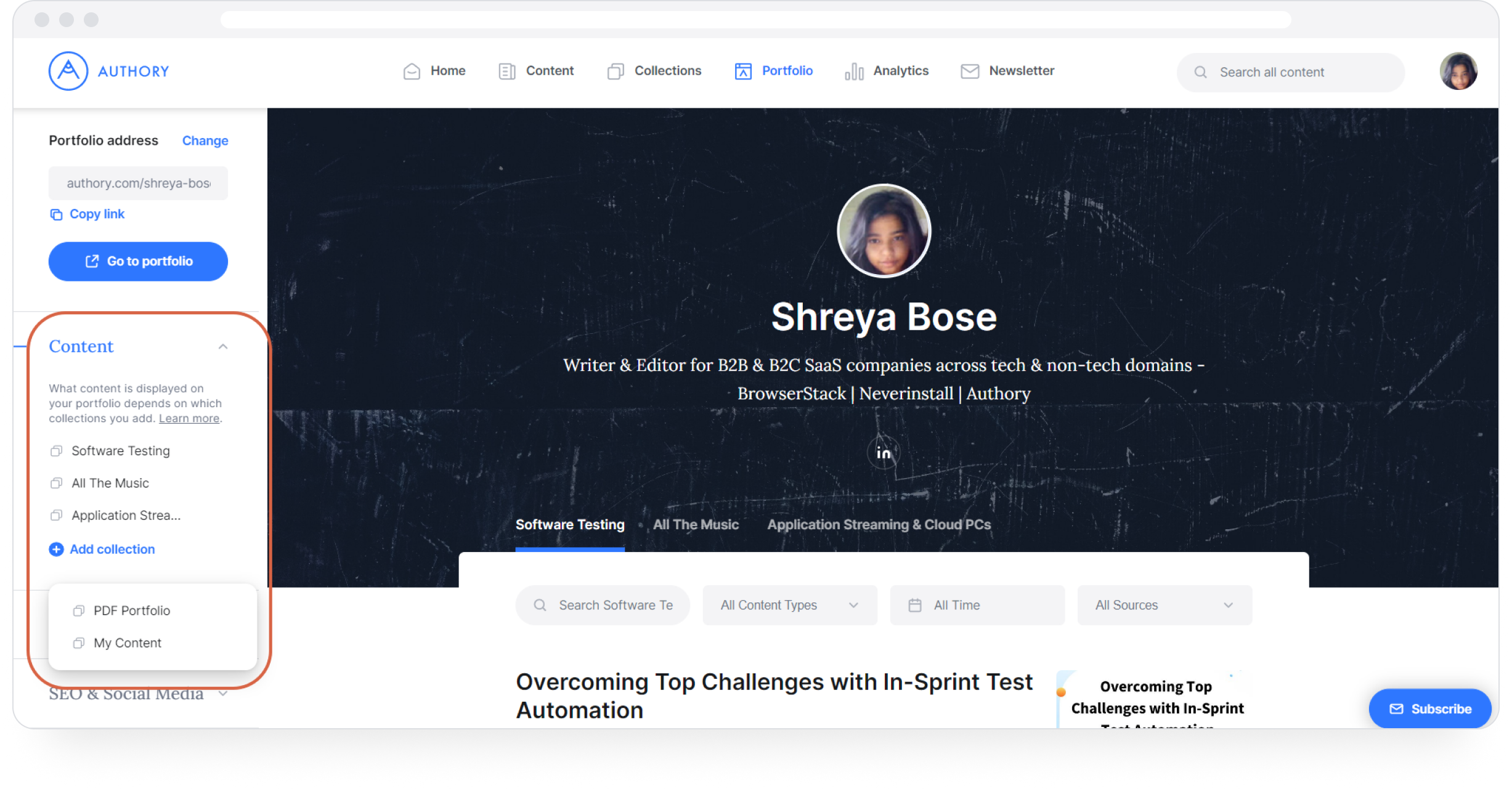
- And you’re done! All documents in the PDF portfolio collection will be added as a separate tab on your portfolio. This is what it will finally look like:
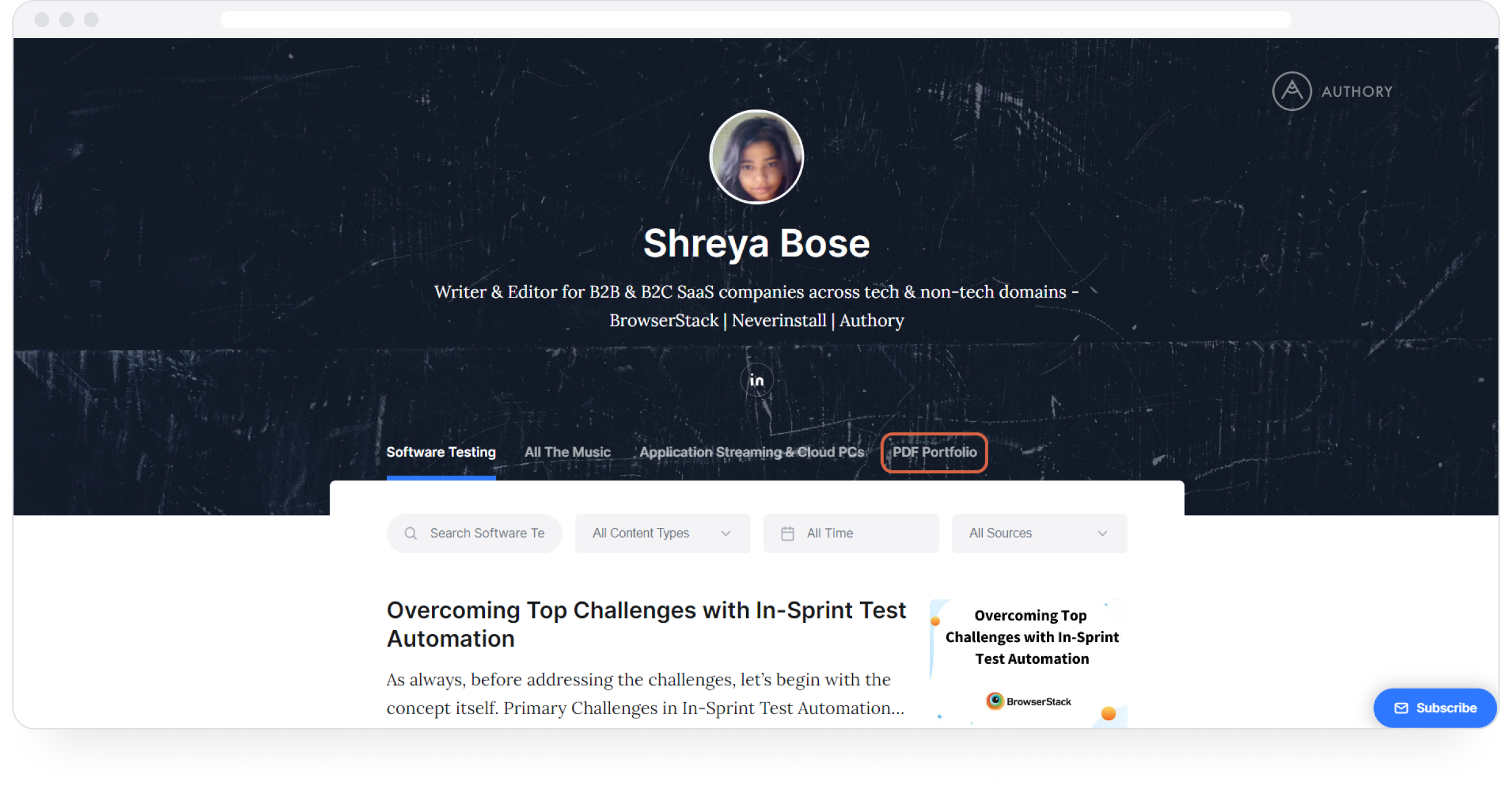
- Anytime you have new PDFs, you can upload them from the add files menu. You can also delete files as you see fit anytime.
Best practices to include in your professional portfolio
Include all or most of your work
Modern-day clients want people who can generate good work regularly, instead of great work once in a while. Add as many work samples as you possibly can, in as many different formats as possible. Whether you have a creative portfolio or a strictly clinical list of past accomplishments, the volume of work counts as much as its quality.
Sure, you can put a few samples and leave it at that. But that's what everyone is doing. To really distinguish your portfolio, present quality work in significant numbers. You'll basically be the "best of both worlds" candidate.
If you're a writer, consider getting an "AI-free" certificate
In the age of AI-everything, there has begun some scrutiny of content writing in this regard. Checks for AI writing but frequent, but detectors are inconsistent. People do actually get blamed for using AI text when they haven't, leading to the loss of clients and opportunities.
To guard yourself against any such suspicions, consider getting a third-party certification of the fact that you do not use AI to write. Authory provides a precise certification that is tailored to the style and tone of each individual writer.
Authory is a portfolio-building tool that helps you build a professional, future-ready portfolio with a couple of clicks. It finds and collects copies of all your bylined articles published online. If you enter the URL of the site(s) where your work is published (with a byline), Authory will automatically import a copy of every existing piece, as well as any piece published (with the byline) in the future.
Sign up, type in a few URLs, and Authory creates and regularly updates a full repository of your work.
Once your Authory database is updated, Authory can use this content repository to prove that your content is, in fact, created by a human writer.
Authory’s big advantage is that it stores and maintains an archive of every customer’s content. Instead of looking at their writing in isolation, Authory’s AI-detection algorithm looks at the writer’s ENTIRE publication history. This allows it to recognize, internalize, and judge each writer’s personal writing style closely, almost without inaccuracy.
Create personalized portfolios when pitching to clients
Your fellow candidates will probably send regular portfolios to the employer — ones with a collection of all or most of their work. If, like you, they have written or created any content across different domains, their portfolio will be a collection of pieces exploring various topics relating to dissimilar, even contrasting, industries.
By sending a regular portfolio, you’re making life harder for recruiters and clients, and you aren’t doing much to set yourself apart.
Now, imagine you’ve sent a personalized portfolio with only the work samples directly related to the client. They don’t have to search for relevant keywords or topic sentences. Everything on the portfolio is tailored to their niche, so they know the exact depth and expanse of your knowledge and skills.
Add a personal message for them within your portfolio (yes, you can do that), and who do you think they will notice above all other aspirants looking to grab that job?
Professional career portfolio examples to study for ideas
Jeff de Cagna (PDF portfolio)
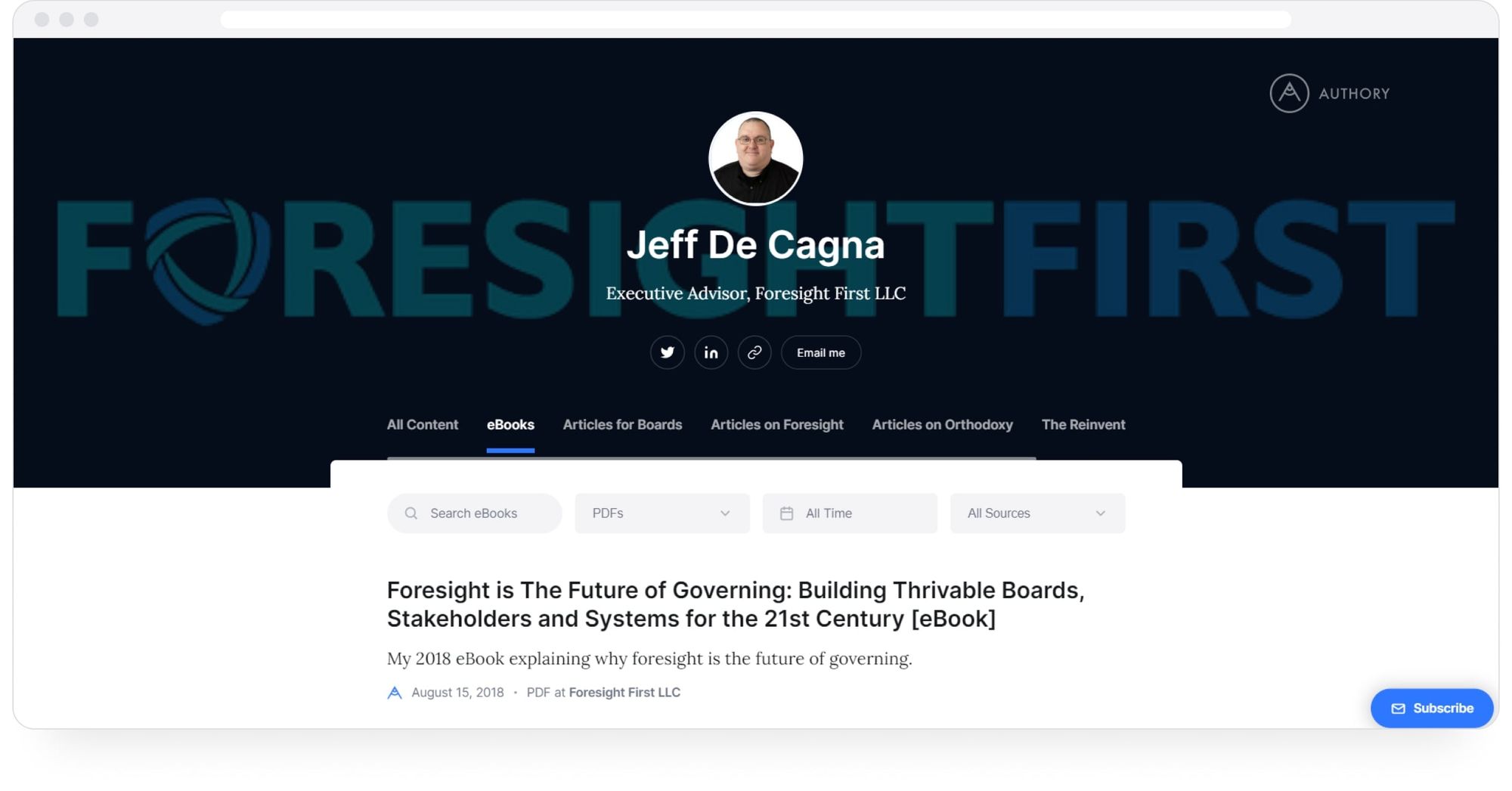
In 2017, after 15 years as Chief Strategist and Founder of Principled Innovation LLC, Jeff de Cagna reinvented his consulting practice to Foresight First LLC, a firm seeking to improve the performance of association boards by “setting a new standard of stewardship, governing, and foresight.” (from his LinkedIn).
Carter Hammett (PDF portfolio)
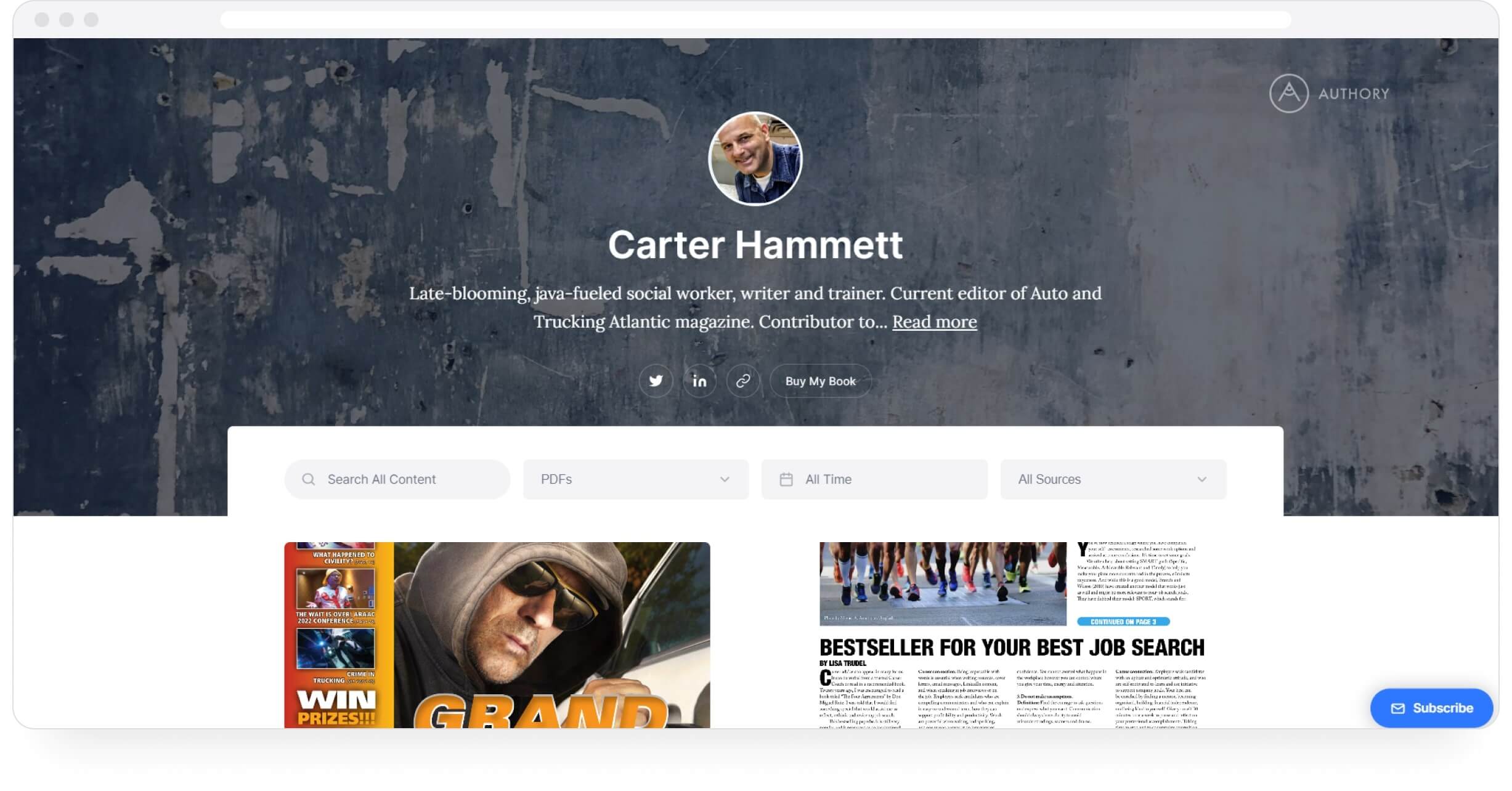
Carter Hammett is a social worker, writer, author, and trainer. He's written three books and is also the manager of employment services with Epilepsy Toronto, which supports the job search needs of people living with epilepsy and related disabilities.
Susan Horsburgh (non-PDF portfolio)
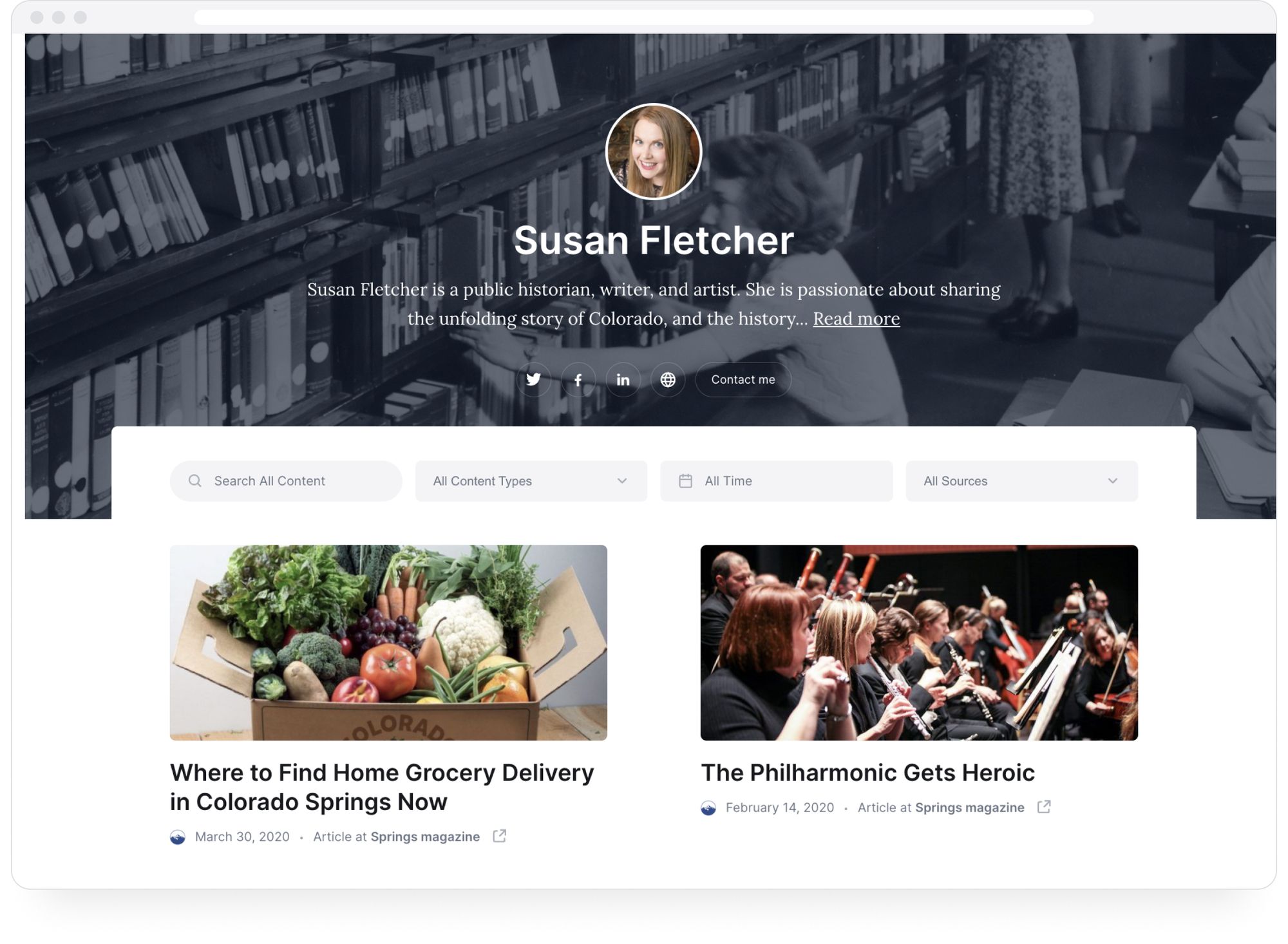
Susan Horsburgh is a journalist and writer with more than 25 years of experience writing news, features, and cover stories for leading international and Australian publications, including TIME, People, The Weekend Australian Magazine, The Australian Women's Weekly, Good Weekend, The Age (Melbourne) Magazine, The Australian Financial Review Magazine, and The Australian newspaper.
Joan McMillan (PDF portfolio)
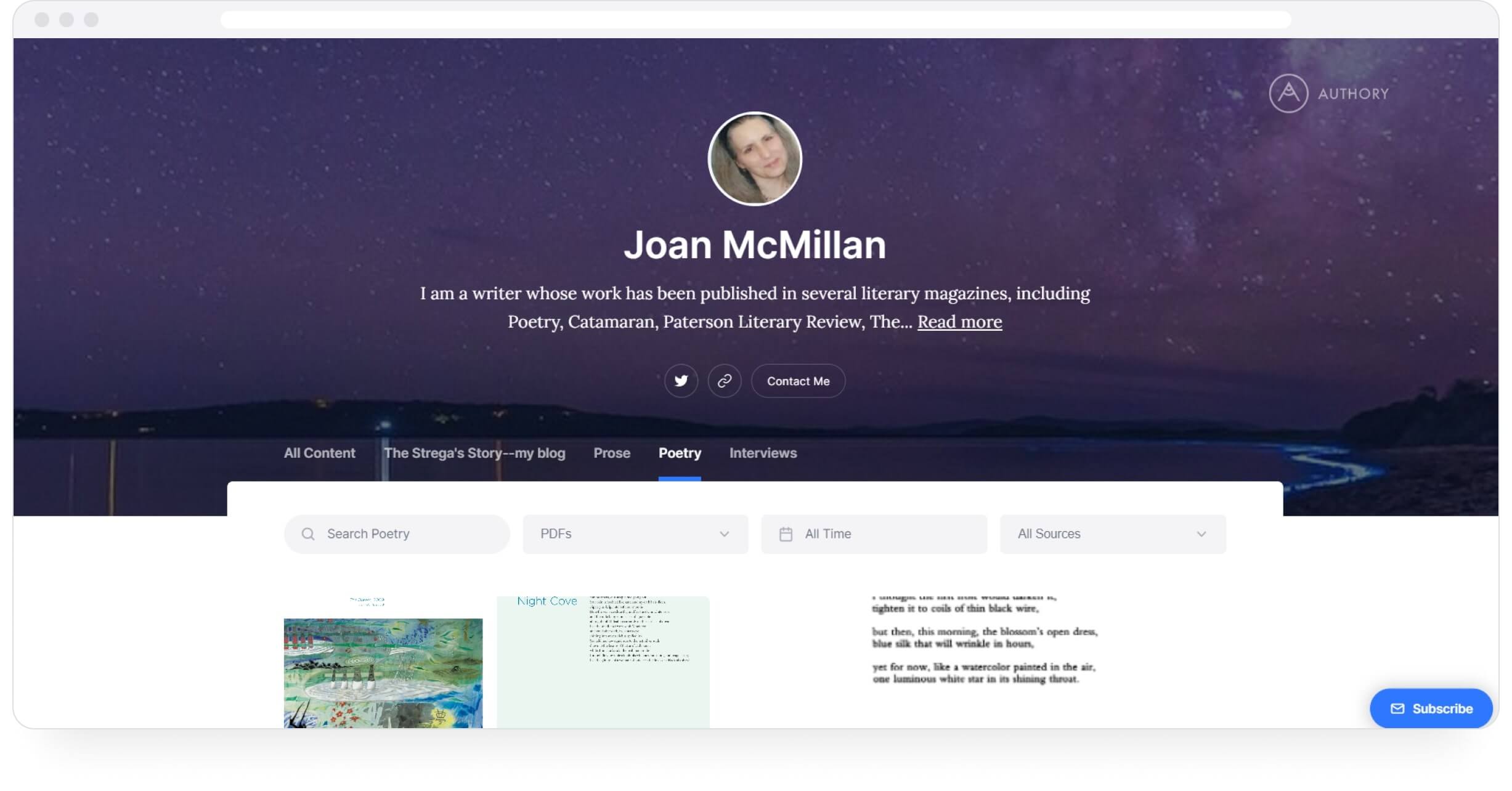
Joan is a writer whose creative work has been published across multiple literary magazines — Poetry, Catamaran, Paterson Literary Review, The Chattahoochee Review, Connotation Press, Santa Clara Review, Santa Fe Literary Review, and more. She is currently writing a romantic comedy set in her hometown of Santa Cruz.
Kevin Johnston (PDF portfolio)
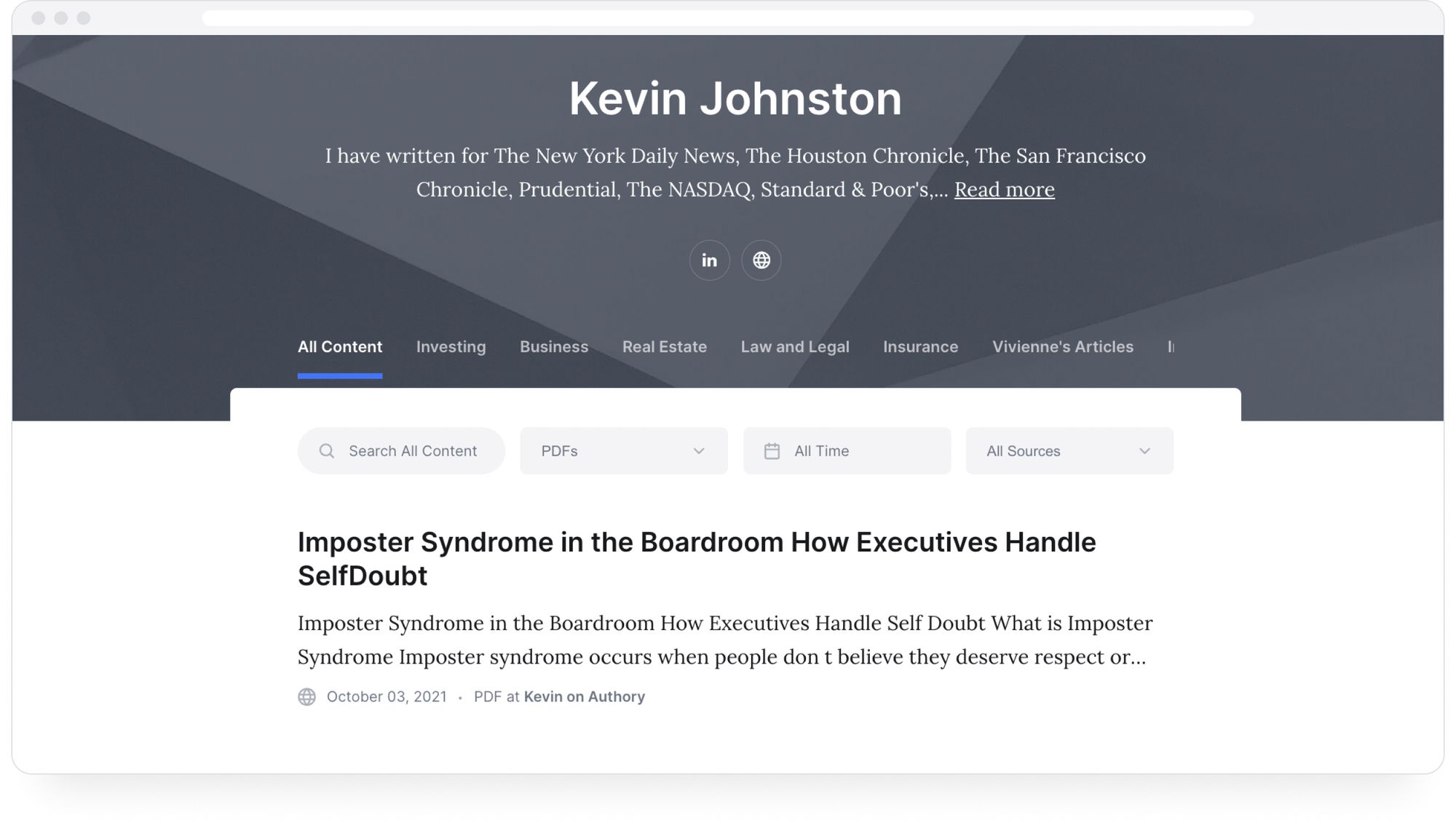
Kevin Johnston has written for The New York Daily News, The Houston Chronicle, The San Francisco Chronicle, Prudential, The NASDAQ, Standard & Poor's, and hundreds of online outlets.
Why consider Authory to create a portfolio?
A self-updating portfolio
Authory will AUTOMATICALLY import a copy of every bylined piece from every site into its own database.
These sites are called "sources." You add as many sources as you want, and every single bylined piece from every single source will be imported automatically. As long as you remember the URL of the site where your work exists, Authory will collate all your content for you in one dashboard.
Authory can import content from behind most soft paywalls (as long as it is a bylined piece) and some hard paywalls. However, it cannot be used to import copies of articles, podcasts, and videos you haven’t created or featured in.
Automated backups
All the content that Authory imports from different sources is saved permanently. Even if the original website where it's published goes defunct for any reason, you'll always have a copy safely stored on Authory's server.
All backups are in the original format — text and/or media. No screenshots.
Continued importing of past and future content
Once you enter a source, Authory won't just import your existing publications. Anything you publish on the same site (after you've fed its URL into Authory) in the future will also be imported automatically. In other words, Authory will import your past and future content.
Authory also sends email notifications for every new piece it imports, so you'll always know if something you submitted has been published.
Apart from these, you also get a slew of miscellaneous but necessary features:
- Ability to search through both your portfolio and your content database to find articles/audio/videos based on keywords.
- All imported content can be downloaded as high-res PDFs or exportable as HTML files.
- Get a custom domain.
- Multiple, low-effort options for customization.
- In-built analytics for real numbers on content performance (engagement, readership) across the web and popular social media sites every 30 days.




